#desert warthog
Photo
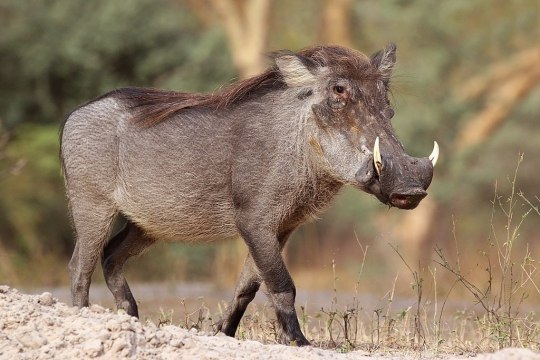
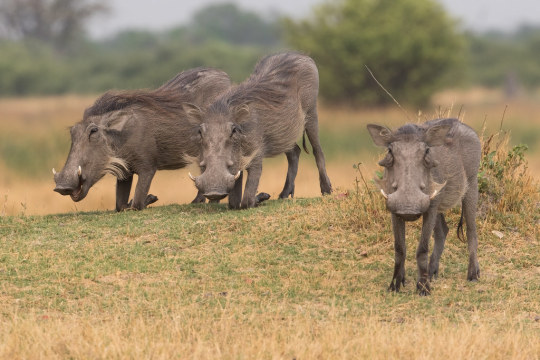

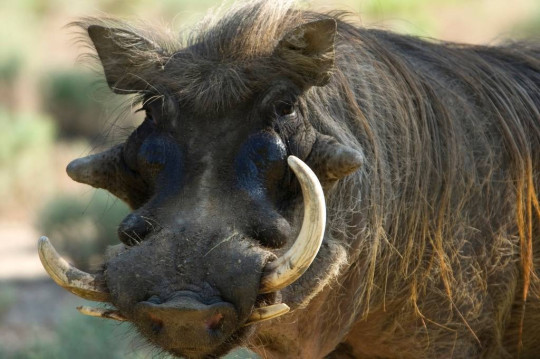
Wandering with the Warthog
Perhaps most famously known for their role in the US animated film The Lion King, the common warthog (Phacochoerus africanus) is a species of warthog endemic to sub-Saharan Africa. Its sister species, the desert warthog (Phacochoerus aethiopicus) is limited to the Horn of Africa’s deserts. Both live in arid scrublands and woodlands; the common warthog also thrive in savannahs, and are the only pig to do so. Both species are also omnivorous, feeding on grass and shrubs, roots, insects, and carrion. They, in turn, are prey for lions, leopards, and cheetahs.
Members of the warthog genus are highly social. Females and their young live in groups called “sounders”, which travel around a home range guarded by a solitary male. Often females bond, raising their young together and sometimes mounting each other while in heat. These bonds can extend to protecting each other from predators and even potential male mates. Males can also form social bonds, although they tend to remain solitary outside the breeding season.
Rutting begins at the end of the rainy season, around June, and continues until the end of the dry season in November or December. During the rut, male boars will seek out female burrows and defend them against other boars. However, typically only the duller upper tusks are used for fighting; the sharper lower ones are saved for predators. Both males and females mate with multiple partners, and males provide no parental care, leaving soon after. Gestation lasts for about 5-6 months, after which females give birth in a burrow separate from the rest of the group. Litters for the common warthog can be as large as 8 piglets, while desert warthogs give birth to only 2 or 3. However, mothers in both species have been observed “allosucking“, or allowing piglets other than their own children to suckle. Piglets take about 6 months to fully wean, although they stay close to their mother until they are fully grown at about 2 years old. Warthogs can live anywhere from 11 to 18 years old.
Both Phacochoerus species are about medium sized, between 63-85cm tall at the shoulder and weighing about 45-75 kilos, with males usually larger than females. Individuals can be coloured grey, brown, or black, and usually sport a coarse mane and brush-like tail that flares up as a warning to predators. Warthogs are also known for their distinctive tusks; both males and females have two pairs that protrude from the mouth and curl upwards. The lower pair is shorter than the upper pair and sharpens by rubbing against the upper pair every time the warthog moves its mouth. P. africanus can be distinguished from P. aethiopicus by their facial features; P. aethiopicus lacks insicors, has a larger snout, and the tips of their ears curl back.
Conservation status: Warthogs are considered Least Concern by the IUCN. Many areas of both species’ range is occupied by parks where they are protected. However, both habitat loss and poaching for ivory are common problems.
Photos
Charlie J. Sharp (via wikipedia)
Michel Gutierrez (via Flickr)
Bernard Dupont
Joel Sartore
#common warthog#desert warthog#Artiodactyla#Suidae#warthogs#pigs#swine#even-toed ungulates#ungulates#herbivores#mammals#grasslands#grassland mammals#scrubland#scrubland mammals#deserts#desert mammals#deciduous forests#deciduous forest mammals#savannah#savannah mammals#africa#sub-Saharan Africa#east africa#animal facts#zoology#biology#queer animals#queer fauna
356 notes
·
View notes
Text
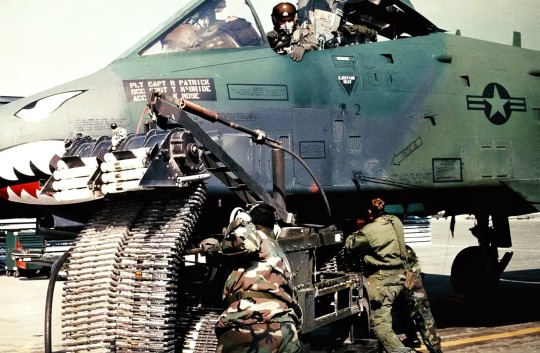
Munitions specialists load 30mm rounds of ammunition into an A-10A Thunderbolt II attack aircraft for its GAU-8/A Avenger cannon prior to a sortie in support of Operation Desert Storm
VIDEO ➤➤ https://youtu.be/DPPHZBvMzvc
#youtube#aircraft#airplane#aviation#dronescapes#military#documentary#aviation history#a 10#a 10 thunderbolt ii#a 10 warthog#warthog#desert storm#GAU#GAU Gun#GAU Cannon#cannon#aviation lovers#republic aviation#aviation photography#aviation industry#airplanes#plane
74 notes
·
View notes
Text
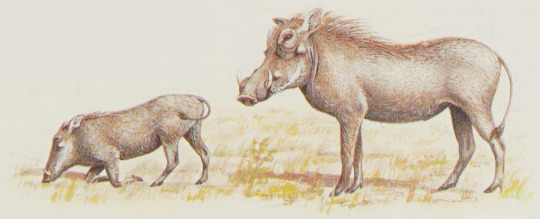
Phacochoerus aethiopicus. Struik Pocket Guides for South Africa: Mammals. Written by John Skinner. Illustrated by Penny Meakin. 1988.
Internet Archive
51 notes
·
View notes
Text
youtube
9 notes
·
View notes
Text

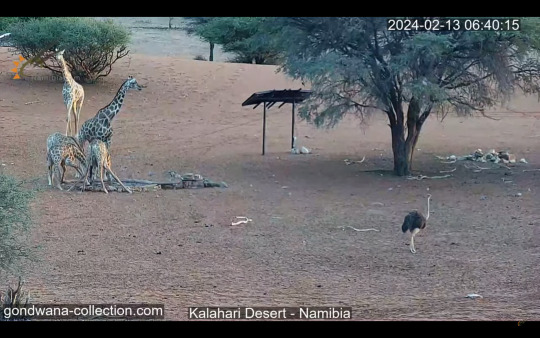
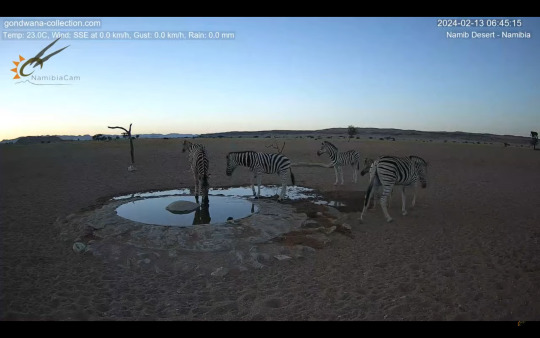


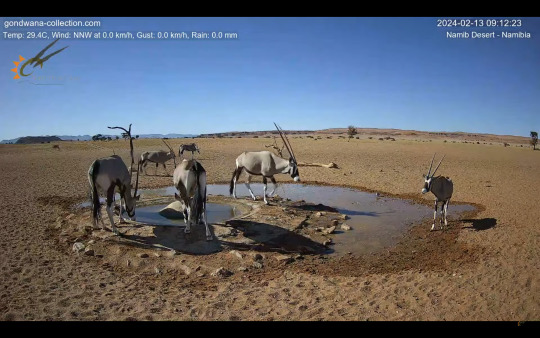

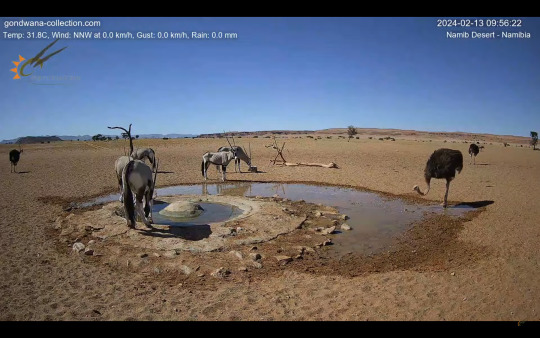
random screencaps I took from the Namib and Kalahari Desert live streams because I have nothing better to do with my life atm
#Namibia#Namib Desert#Kalahari Desert#Africa#African wildlife#animals#wildlife#giraffe#ostrich#gemsbok#springbok#zebra#antelope#jackal#warthog
3 notes
·
View notes
Text
Everyone says Grif and Simmons were hooking up in the warthog or that they weren’t, but what about the secret third option where they were going to hook up and Simmons was like, “hey, we may be in the middle of nowhere but we’re still outside, maybe we shouldn’t take our clothes off??” And Grif’s like “dude. No one is looking.” And Simmons is like “BUT THEY COULD BE” and they just bickered back and forth about if you could be added to the sex offender registry for fucking in the shade in the middle of a desert away from all the other people in the area and THATS why Grif is like “well, I can tell you what we weren’t doing” and Simmons rolls his fucking eyes but honestly the whole thing is just funny to them both bc it stopped being about actually fucking so quickly and just devolved into their normal sitting around and talking
866 notes
·
View notes
Text
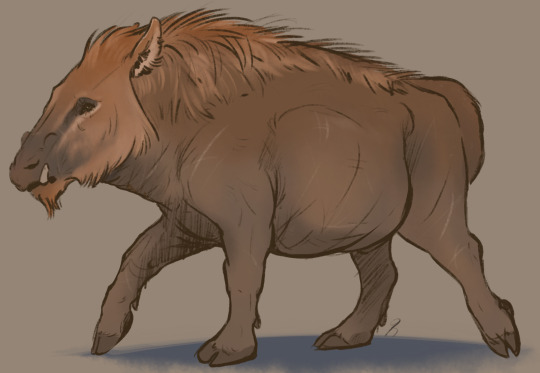
Not a whole lot to work with on this week's Bestiary Posting.
That said, the Dikebael (that is an unfortunate name, isn't it) is apparently a 'large African desert animal that lives in herds', and honestly my first thought was camel. I don't know if the description is meant to be a camel as it does specifically say 'untamed' and well, there aren't any wild camels in Africa - at least not nowadays.
So I started out sketching something very camel-like, but my mind sort of wandered to peccaries, which are found in deserts. So I went with a large peccary-like animal and kept a few camel-like features - particularly the nose, and long eyelashes to keep the sand out and large padded feet to support their weight when walking on shifting sands. As the description mentions single males dominate a herd of females, I decided that, like the African lion it needed a mane to protect itself from attackers, and tusks like a warthog to ward off any challengers. The mane also protects it's back from the beating sun. So at this point, it really just looked like an enormous warthog, but I'm cool with that. Like a lion I gave it deepset eyes as well as the white circle below to reflect light into the eye to help them see in low light. Lastly, I wanted to incorporate a fatty hump like a camel, so they could store energy for hard times. Instead of on their back, I opted to make it their tail, like the fat-tailed sheep breeds.
I think I just ended up drawing a stocky entelodont really.
40 notes
·
View notes
Text
Bestiaryposting Results: Dikebael
This animal's name is, admittedly, a bit of a "Tirion upon Túna (upon Rye)" situation in that I did not process that there was anything unusual about the name until, shortly after the entry went up, it got a "heh. Dick-ball" reply. (And they weren't alone; at least one of the art posts that's gone up has acknowledged the unfortunate name.) It probably doesn't help that this entry references the animal's testicles.
I can't even go, "well, it's not pronounced like that," because by the orthographical rules of the conlang I used to generate these names, it would be pronounced /dɪ·kɛ·bæ·ɛl/, so the start still pretty much sounds like "dick". I'd say I'll be more careful about that in future, but I scheduled all of these ahead of time and I'm not sure it's worth digging through the queue, so we'll just have to see.
Anyway, for anyone who's not sure what this whole "bestiaryposting" thing is, you can find an explanation and previous posts here: https://maniculum.tumblr.com/bestiaryposting. The entry that people are working from this time is here:
(Also, I just want to remind anyone reading that you're free to join in -- this is not a closed thing, just check out the "maniculum bestiaryposting" tag and sort by latest to see what the current beast is. Felt I should say that since we've had the same group of people for a while and I don't want anyone seeing the same set of usernames each time and thinking this is an exclusive club.)
Anyway, art below the cut in roughly chronological order.

@sweetlyfez (link to post here), acknowledging the lack of physical description in the entry, has opted to just have fun with it and put together this strange chimerical creature. I think the flat little horns on top of its snout are really interesting -- the linked post describes them as functioning like a stone circle to make sure it has the right date for its annual announcements. I have no idea if that would work at all, but it seems like it fits the general logic of the bestiary, and I like it.

@silverhart-makes-art (link to post here) has an interesting explanation in the linked post about how they decided to combine features of various desert-dwelling animals with the basic body plan of a peccary (which is apparently the same animal I know as a "javelina" -- I learn a lot looking stuff up while I write these posts). They then acknowledge that, without the context of all the things they're working in here, it kind of just looks like they've drawn a very large warthog. It's a very good hog, though. Something neat that you might miss if you're just looking at the drawing without the context of the post, for instance, is that it has the same fat-storing tail as a fat-tailed sheep. For more little bonuses like that, check out the linked post.

@cheapsweets (link to post here) has given us a whole herd of critters here. They've also hooked onto the "desert" thing due to the lack of physical description, collected traits from real-world animals that make them successful in a desert biome, and combined them into a new creature. They make me think of jackals, which aren't mentioned in the linked post, and also make me think of donkeys, which (kind of) are. Let's all take a moment to note the baby hiding behind a pile of rocks to the right, watching a smaller animal of some sort. I think it's cute.
CheapSweets also wonders about the significance of March 25th, and I have to say so do I. It's not explained in the text. The symbolism bit does say they call the same number of times during the day and night to represent the devil wanting to make day and night the same, which... what?
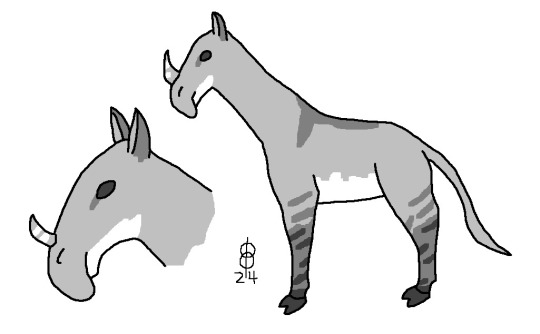
@pomrania (link to post here) clarifies that this is a grayscale rendering and that the animal would actually be a sort of dusty tan in a color version. They also went the direction of "this animal lives in the desert, so let's focus on desert adaptations." So we've got the split hooves and nostrils that can close to keep out sand. I particularly like the overhanging lip; it adds a certain charm, I think.
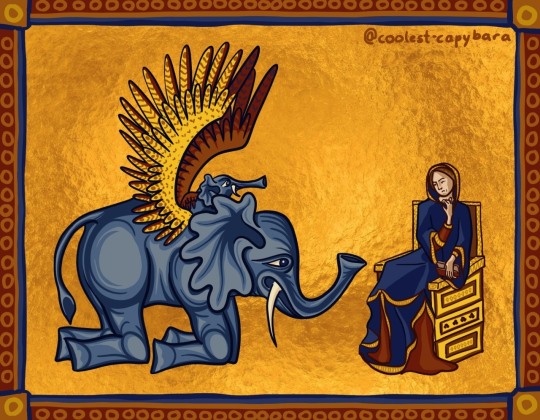
@coolest-capybara (link to post here) has decided that this is an excellent excuse to draw an elephant, since we're short on specific description beyond them living in Africa and being able to make loud noises. As a bonus, this means that the young Dikebael can be conveniently hidden behind the mother's large ears. The other aspects of this illustration relate to Coolest-Capybara having a pretty solid theory as to "why March 25th" -- apparently that's the Feast of the Annunciation, which of course the medieval author would have known. So here we have the Archelephant Gabriel trumpeting at Mary. (Actually it seems like the baby is doing the trumpeting, and it looks adorable doing it.) The linked post describes the medieval artworks that are being referenced in the illustration, so I recommend checking that out.
Anyway, time to check the Aberdeen Bestiary...
... well, we can't, actually. The Aberdeen Bestiary is missing a few folios, and this is on one of those. I got the text from MS Bodley 764, since I have a print translation of that one and it's fairly similar. For the illumination, we're going to go to the digitized Ashmole Bestiary, which is even more similar but I don't have a translation of it.

So this is the onager or wild ass.
Interestingly, it looks pretty much identical to the image of the tame ass on the same page, but to be fair, I don't think I'd be able to distinguish between an onager and a donkey with any reliability. Makes one wonder why they have separate illustrations, though.
And yeah, I have no additional explanation for why... any of the stuff in the entry.
38 notes
·
View notes
Text
Halo Reloaded: Advice... Again
Fred-104 was sprawled on a moth-eaten couch that had seen better days, probably around the time the Covenant thought humans were an easy target. He was idly flipping through a digital magazine, "Cuisine for the Super-Soldier Soul," a title so absurd it had to be military issue.
Kelly-087 was beside him, her legs thrown over his lap in a casual display of affection, her attention on a holoscreen displaying a list of 'Top 10 Quiet Getaways for the War-Weary Soldier.'
"Look at this," Kelly said, pointing at a blip on the screen. "There's a place that serves a dish called 'The Master Chief.' It's essentially a steak so tender it sneaks up on your taste buds."
Fred chuckled, the sound gruff but warm. "Sounds like something John would accidentally invent and never realize it's named after him."
Their banter was abruptly interrupted by a sound resembling a Warthog crashing through a supply depot. Except this depot was their living room window. Glass sprayed across the room, a makeshift reminder that peace was always temporary.
John-117, the epitome of Spartan stoicism and the most unlikely window-smasher, lay amid the chaos he'd created, looking momentarily perplexed by his own entrance. Fred and Kelly, veterans of countless battles, could only stare.
"John, ever heard of knocking?" Fred finally said, his tone dry enough to make a desert jealous.
Kelly, ever the pragmatist, was already calculating the cost of replacing the window. Again. "Or, you know, using the door like a normal person?"
John rose, shaking off glass like a dog shedding water. "Apologies for the dramatic entrance. I require... assistance."
Fred raised an eyebrow, a smirk playing on his lips. "Did you run out of doors to knock on?"John's gaze was serious, a storm brewing over an ocean of uncertainty. "It's Linda. I need to ask her out. On a date."
Silence enveloped the room, punctuated only by the distant hum of the station's life support systems. Kelly and Fred exchanged a look, a silent conversation passing between them.
"You flew through our window... for dating advice?" Kelly's voice was a mix of incredulity and amusement.
John, unfazed by the absurdity of his actions, nodded. "Yes."
Fred stood, adopting the stance of a mentor about to impart wisdom upon a wayward student. "Well, step one: don't start by breaking her personal belongings. It tends to set the wrong tone."
Kelly, finding her voice again, added, "And maybe try using words. 'Linda, I value our time together both in and out of combat. Would you be interested in exploring a more... personal mission with me?' See? Easy."
John considered this, his brow furrowed in concentration. "No tactical overlay? No mission brief?"
"Definitely not," Fred deadpanned. "Try to sound less like you're planning an assault on a Covenant stronghold and more like you're, you know, human."
A moment passed, then John nodded, a determined glint in his eye. He turned, assessing the room with a tactical eye that unfortunately included the remaining intact window.
"Not again," Kelly sighed, already knowing what was coming.With the grace of a Spartan (which, in domestic settings, translated to 'bull in a china shop'), John made his dramatic exit through the second window, leaving a trail of destruction in his wake.
Fred and Kelly, now facing the prospect of explaining to UNSC property management why two windows needed replacing due to 'Spartan relationship advice,' couldn't help but laugh.
"Dinner and window shopping, then?" Fred quipped, offering his hand to Kelly to pull her up from the couch.
"Let's just hope the restaurant has a discount for heroes," Kelly replied, accepting his hand with a smile. "Because at this rate, we're going to need it."
#halo#halo fanfiction#halo fanfic#master chief#john 117#master chief fanfic#master chief fanfiction#halo headcanon#halo au#helix studios117#halo reloaded#Ultimate halo#fred 104#fred/kelly#fred 104 x kelly 087#john 117 x linda 058#linda 058#john/linda
29 notes
·
View notes
Text
me: hey youtube, i'm really into gunpla lately, i like watching videos about gunpla kits. i have no privacy from you, you know all this already. so what's...
youtube: vinyl anime girl figurines in bikinis, you wanted?
me: no, that's not... gunpla. i like gundam plastic model kits. i wanna admire all the little detail in kits i don't have and learn some modelling techniques to apply to the ones i do.
youtube: ahh, gotcha. here's ww2 nazi germany panzer tank model kit reviews.
me: no! gundams! model kits of fictional giant robots! tiny 1/144 scale model kits of fictional giant 20m tall robots with laser swords they hold in their hands and put in cool poses! fictional. robot. kits.
youtube: this nazi half-track truck is considered one of the best 1/32 scale model kits for beginners, it comes with a full mechanised infantry support unit to paint, with accurate uniforms.
me: no.
youtube: best imperial japanese army fighter aircraft model kit 2023?
me: robots! fictional. robots.
youtube: ahh, best imperial japanese navy battleship model kit 2023.
me: listen, you...
youtube: a-10 warthog desert storm camouflage custom painted model kit!
me: STOP! i don't want vehicles of war! look i get it, gundam is a franchise about the horrors of war and we all missed the point in favour of 'wow cool robot' or lately 'omg cool yuri private school romance' or whatever, but it's not real. they're not real machines. it's not a real war, it's fiction. i can build these little guys as a distraction from the impending war here, from the existing wars, from the horrors of wars burned into my brain by live television news, i can love the zaku and zgok without conflating the republic of zeon with real world military superpowers seeking to dominate the globe and becoming a fascist fetishist because of anime robots.... i don't want to watch creepy old men salivate over scale model sculpted detail in planes with gattling guns that mowed down civilians, real human civilians, in real life wars. i want to watch energetic irish homosexuals rank the single-joined elbow posability of a bright red mech with a laser axe that'd be larger than a building, if it were real, which it is not, because these are toys for playing with, not historically accurate recreations of actually extant machines of horror and death. there is a difference! surely there is some confluence of keywords and user engagement metrics that can elicit an echo of understanding the difference in your unthinking algorithmic fever dream of signals????
youtube: ...
me: *panting with rage*
youtube: .....balloon titty anime bikini girl with the sculpted face of a scared crying child? it's a model kit!
18 notes
·
View notes
Text

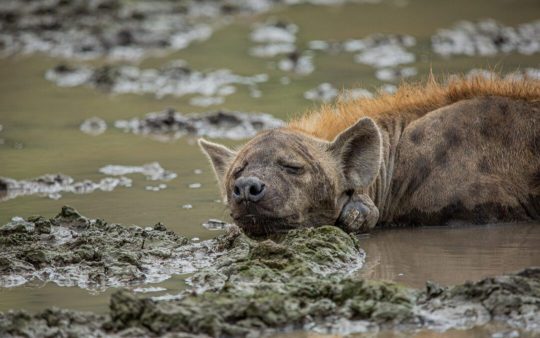

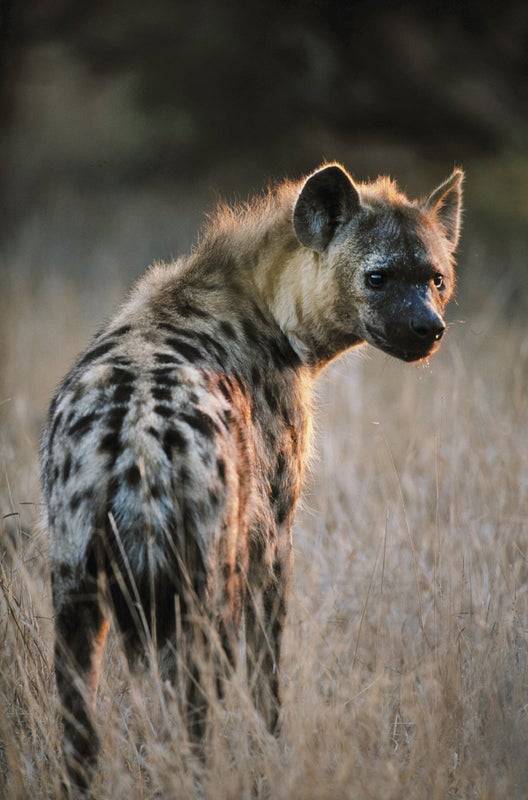
Say Hi to the Spotted Hyena
The spotted hyena is also known, perhaps most famously, as the laughing hyena (Crocuta crocuta). This species once ranged throughout Eurasia, but following the end of the Ice Age was restricted to sub-Saharan Africa. Today they can be found in many types of dry, open habitat, including savannah, semi-desert, and mountain forests. At times, the spotted hyena may also enter urban areas in search of food.
Unlike other hyenas, Crocuta crotuta is a predator, not a scavenger. They most commonly prey on wildebeast, but they may also hunt zebra, gazelles, Cape buffalo, and warthog. In addition, desperate times may cause packs to hunt on more dangerous prey such as young hippopotamus, giraffe, and rhinoceros. Spotted hyenas have incredible endurance, reaching speeds of 60 km/hr (37 mph); a single chase can last over 24 km (14 miles). When live prey is scarce, the laughing hyena can also turn to carrion, as well as snakes and ostrich eggs. In turn, this species may be killed by lions, though this may be motivated more by competition than prey drive.
Spotted hyena females are typically larger than males, weighing 44.5–67.6 kg (98–149 lb) to the males' 40.5–69.2 kg (89.3–153 lb). The height range for both sexes lies between 70–91.5 cm (27.6–36.0 in). In addition, female laughing hyena are somewhat famous for their masculinated genetalia; the clitoris is enlarged, resembling a penis, and is accompanied by sacs filled with fibrous tissue that resemble a scrotum. As the name implies, the coat is light brown with darker spots over most of the body. Because the species has such a wide diet, it has was is considered to be the strongest in relation to size of any mammal. The bite force is stronger than that of a brown bear, and can exert a force of 4,500 newtons-- enough to crush bone.
The laughing hyena is a highly social animal, and individuals live in communities up to 80 strong; size largely depends on prey availability and whether or not the group migrates. A clan territory can be anywhere from 40 km (24 mi) to 1000 (621mi) squared. Females dominate the males, and a pack is usually led by a matriarch. Hierarchies are strictly enforced, and positions are primarily inherited through birth and transferred through death. In addition, one's rank is maintained and recognized through social alliances and their contributions to the clan rather than size or dominance displays. The entirety of the clan comes together most often when defending a territory, gathering at the communal den, or at a kill; however, these kills are more commonly produced from smaller offshoots of the clan.
Crocuta crotuta can breed year-round, though mating is at its peak during the wet season from April to June. Members of both sexes pair indiscriminately with multiple mates, both within their clan and without. To offer himself, the male performs a mating ritual in which he lowers himself to the ground before the female, and retreats if any aggression is shown. Once impregnated, the female carries for about 110 days before giving birth to two cubs-- three is fairly rare. Weaning takes another 14 to 18 months, during which time cubs learn to hunt and defend the clan, as well as establish their place in the social hierarchy. Sootted hyenas reach maturity at about 3 years old, and can live an average of 12 years in the wild, though individuals as old as 25 have been recorded.
Conservation status: The spotted hyena has been determined Least Concern by the IUCN. However, outside protected areas the population is declining due to deforestation and hunting as a nuisance species.
If you like what I do, consider leaving a tip or buying me a ko-fi!
Photos
Augusto Bila
Elise Pianegonda
Evie Davidian
Art Wolfe
#spotted hyena#Carnivora#Hyaenidae#hyenas#carnivores#mammals#savannahs#savannah mammals#grasslands#grassland mammals#scrubland#scrubland mammals#africa#sub saharan africa#animal facts#biology#zoology#requested
175 notes
·
View notes
Text
Snow capped mountains across a vast desert.
A massive corral of tall barbed wire fencing, filled with massive warthogs and lions.
A city swirling with cloudy multicolored lights, a gargantuan glowing face screaming threats among the whorls.
An older woman in a long brown coat who has combined with a malevolent creature of metal, sticking people fatally with the deadly syringe at the end of her extendable steel arm. her army of nanobots approaches from across the desert
A tall chamber filling up with water, its inhabitants forced to tear panels from the ceiling to use as flotation devices.
A killer limping across the floor as he struggles to maintain a human shape, wet smacking and slithering sounds emanating from beneath his skin, his eyes leaking bloody tears.
Survivors stumbling through an abandoned mall, filing silently along stairs and hallways so as not to attract attention
^^^ crazy shit that happened in a single dream I had between alarms this morning.
#also at the end of the dream i was so sick of all the freaks around trying to kill me simultaneously#that i buried myself under a pile of stuffed animals so they couldnt find me
54 notes
·
View notes
Text
Warrior Prefixes: African / Ancestor Clans (LeopardClan, LionClan, & TigerClan)
Words that aren't derived from things in Africa aren't included; this list is made based on the Ancestor Clans and naming rules from the roleplay server Call of the Wild!
170+ prefixes under the cut!
A
Aardvark-
Aardwolf-
Acacia-
Addax-
Adder-
Albatross-
Alligator-
Aloe-
Amaranth-
Amaryllis-
Amra-
Anaconda-
Anise-
Antiaris-
Antelope-
Aphid-
Argan-
Artichoke-
Asparagus-
Aye-aye-
B
Babool-
Baboon-
Badger-
Bamboo-
Banana-
Baobab-
Barb-
Barberry-
Bat-
Bee-
Beetle-
Begonia-
Bindweed-
Boa-
Boar-
Bologi-
Bongo-
Bonobo-
Bontebok-
Boomslang-
Boxwood-
Brubru-
Buffalo-
Bushbuck-
Buzzard-
C
Camel-
Caper-
Caracal-
Caraway-
Castor-
Cherry-
Chimpanzee-
Cichlid-
Citrus-
Civet-
Clover-
Cobra-
Cocoa-
Coconut-
Coffea-
Crane-
Crocodile-
D
Dassie-
Desert-
Detar-
Dik-dik-
Dingo-
Dittany-
Duiker-
E
Eagle-
Eel-
Eland-
Elephant-
F
Fennec-
Fennel-
Fig-
Firefly-
Fossa-
Fraxinella-
G
Galega-
Gazania-
Gazelle-
Gelada-
Genet-
Geranium-
Gerenuk-
Ginger-
Giraffe-
Gorilla-
Gowé-
Guava-
Gum-
Gundi-
H
Hanza-
Hare-
Hartebeest-
Hawthorne-
Hedgehog-
Hippo-
Holly-
Hornbill-
Hyena-
Hyrax-
I
Ibis-
Impala-
Iris-
Ivory-
Ivy-
J
Jerboa-
K
Kalanchoe-
Kanna-
Khus-
Killi-
Knotgrass-
Kob-
Kokum-
Kola-
Kudu-
L
Lemur-
Liquorice-
Lily-
Loach-
Locust-
M
Macaque-
Mahaleb-
Mahogany-
Mamba-
Mandrill-
Marshmallow-
Marula-
Meerkat-
Melde-
Mitzeeri-
Mongoose-
Monkey-
Myrrh-
N
Nettle-
Nightshade-
O
Okapi-
Okra-
Oleander-
Olive-
Ostrich-
P
Pangolin-
Pea-
Peacock-
Penguin-
Periwinkle-
Plantain-
Plum-
Pomegranate-
Porcupine-
Python-
R
Ratel-
Redoul-
Rhinoceros-
Rooibos-
Roselle-
S
Sable-
Sambar-
Savannah-
Scarab-
Sedge-
Serval-
Shea-
Shoebill-
Shrew-
Sitatunga-
Springbok-
Spurge-
T
Tamarin-
Tapir-
Tilapia-
Topi-
Tortoise-
Tulip-
Turtle-
V
Vetiver-
Violet-
Viper-
Vulture-
W
Warthog-
Waterbuck-
Wildebeest-
Wolf-
Woodruff-
Wormwood-
Y
Yak-
Yohimbe-
Z
Zebra-
#last updated: 3/4/2024#warrior names#prefixes#/ Region:#Africa#/ Clan:#Ancestor Clans#LeopardClan#LionClan#TigerClan#/ Roleplay:#CotW#Call of the Wild#/ Reach:#TumblrClan#warriors#warrior cats#warriors oc#warriors roleplay#oc inspiration#oc inspo
9 notes
·
View notes
Text
AWUKHOZIEL TRIBES
ADMUSZROKTEBI: This is the first Awukhoziel tribe to be formed, being well-known for their exceptional mastery over agriculture, hunting, fishing, weaving, beast-taming, and peacekeeping. They’re also known for their festivals dedicated to the titans, elaborate dancing, melodious music, exquisite taste in the visual arts, and oral storytelling. In regards to their tribal name, Admuszroktebi means “children of the red earth or man’s offspring”. All members are born with pallid, snowy or ashen skin that have scattered brown moles or rufous or dark grey freckles and purplish, pinkish or silvery stretch marks. Men’s hair is often medium in black and various shades of natural red, while women usually have long hair with different tones of blonde and brown. Admuszroktebi men wear cacophonous moon-elk loincloths, one-shouldered mantles of various dyed colours, girdles of dried pomegranates and golden bells, shawls with tassels, straw hats, phylacteries, and leather sandals. Admuszroktebi women wear rosy-throated warthog undergarments, richly ornamented mantles, girdles of dried blueberries, crape myrtle, and silver bells, veils, and rope sandals. They also wore long, low-necked silk dresses of many colourful patterns with the bodice being open all the way to their waist, exposing their breasts. Religious chieftains and chieftainesses wear very similar clothing to the other tribal members, but there are noticeable differences. Their clothing has more embroidered intricacy and they wear jewellery, crowns of flowers and feathers, and leaf undergarments, while their hair is decorated with gemstones and ribbons. Guards and infantrymen wear bronze armour that consist of animalistic helmets, gorgets, pauldrons, bell cuirasses, vambraces, gloves, and greaves. They also wear knee-length rhinoceros skin skirts with gold embroidery and they carry fish-scaled kite shields, halberds, daggers, and battle-axes. Their government is a bit democratic, but it has some leniency to the elected chieftain and chieftainess who represent the people and values of the tribe. A new pair would be elected for a few solid reasons: (1) tyranny has become prevalent or evil intentions are realised by the populace; (2) the previous experienced a soul-crashing loss that impedes their rule; (3) death or serious illness has occurred; and (4) the old pair wants to give others a chance, letting them retire or take a break from their position. Their currency is replaced with exchanging materials of mostly equal value through authenticity, condition, and weight. They live in temperate forests and bogs where land, vegetation, animals, and bodies of water are plentiful, and their architecture is a blend between Minoan, Achaemenid, and Pakistani.
HUBASZROKJI: This is the second Awukhoziel tribe, being well-known for not possessing a military due to having a strong distaste for war. They’re also known for their strict religious beliefs, blacksmithing, brewing, hard focus on community and family, and frequent trades. In regards to their tribal name, Hubaszrokji means “beyond the desert or across the river”. All members are born with pallid or ashen skin, black moles, and faint pinkish or brownish stretch marks. The hair of men is usually medium in glossy black, white smoke, vanilla, and different shades of brown, but some are short. Women’s hair is long and medium in matte black, seashell, parchment, and different shades of brown. They’re also known for their valuable merchandise, knowledge of accessible trading routes, strict religious policies, and high respect for the titans. Hubaszrokji men wear mid-thigh silk under-tunics, ornate sleeveless cloak-like garments of linen, croaking wolf breeches, colourful robes, and rope sandals. Hubaszrokji women wear elaborate aprons woven out of gold, blue, purple, and scarlet threads, heavy woollen shawls, robes of finer material, proboscis camel underdresses, and leather sandals. Kings and their heirs wear similar clothing to male civilians, but they have sackcloths to cover their loins, sleeved cloak-like garments of goat hair with tassels at bottom, and well-decorated and vibrant robes. They also wore girdles of rope and dried flowers, turbans adorned with gold and jewels, and personalised pieces of clothing. High-ranking priestesses and hierophants wore very similar clothing to the civilians, but they had rope girdles, velvet turbans, dull-toned robes, and golden frontlets. They also have breastplates attached to their aprons by gilt-brass chains tied to bronze rings on the shoulder straps. These breastplates are decorated with twelve different gemstones that have unique meanings: in the first row, jade (forthrightness and remembrance), moonstone (purity and chastity), and garnet (truth, constancy, and virtue); in the second row, amethyst (sincerity and sobriety), aquamarine (courage and hope), and chrysolite (happiness); in the third row, alexandrite (justice, contentment, and strength), sapphire (wisdom, love, and loyalty), and zircon (respect). Their government is a republican monarchy where citizens are entitled to vote for those who are spiritually and intellectually fit to be kings, high-ranking priestesses and hierophants, and religious judges. Their currency consists of coins made from low-quality electrum to average silver and brass to expensive gold. They live in the cooler deserts as well as tropical savannas, and their architecture is a mixture between Iranian, Etruscan, and Herodian.
PRIJAKHOSZLUMNE: They’re the third Awukhoziel tribe, being well-known for their hard focus on the matriarchy, all-male slavery, strict gender-based laws, and bloodthirsty pillages. They’re also known for their prominent record-keeping and use of alchemy, cartography, jewellery crafting, mummification of corpses, brothels, and gargantuan temples dedicated to the Hirczalotepus Tejasozuri. In regards to their tribal name, Prijakhozlumne means “mansion of the spiritual river, middle of the world’s heart or earliest spring dew”. All members have ashen skin that has scattered black or cinereous moles and pinkish stretch marks. The hair of men is medium in black and different shades of brown, while women’s hair is either long or medium in black and different shades of brown and red. Prijakhozlumne men simply wore dirty, tattered wrap-around skirts belted with a crudely made girdle of robe, bells, and dried leaves at the waist. Prijakhozlumne women wear knee-length tunics with short sleeves and a round neckline, fringed shawls of wool and embroidered geometric designs, ankle-length sheepskin skirts, brooches, hair ornaments, neck rings, and leather sandals. The empress wears a cacophonous moon-elk dress, white, sky blue, vermillion, and bronze robes of silk, a floral ribbon-like sash, elaborate golden jewellery encrusted with semiprecious stones, and a pschent plus a golden royal vulture-like headdress that has the head of a rearing cobra. Princesses and noblewomen wore similar clothing to the empress, but their main differences come in rosy-throated warthog dresses, delicate hair ribbons, and headdresses of gold leaf, lapis lazuli, carnelian, feathers, and their birthstone. The hierophant wears saffron-lacquered silk and linen orange robes, a leopard-spotted kesa, ballooning white damask trousers, a straw conical hat, and rope sandals. Prostitutes wear a two-strap network dress with an edge that’s below the breasts and they’re embellished with beads or feathers at the bottom. They also wear tasselled shawls of linen, robes of scarlet and purple, black veils, necklaces of golden pearls, earrings, anklets, and nipple piercings. Record-keepers and alchemists wear ivory, red, gold, and purple robes, gilt brass or silver masks of stylised animal heads, baggy pants, bronze armlets, gemstone amulets, velvet loincloths, girdles of cord, bells, dried flowers, and amethyst beads, and wool boots. Warriors wear lacquered iron attached-visor helmets with a sculpted lóng holding the sun and elk horns, and gilt-brass cuirasses, vambraces, thigh and calf guards, pauldrons, and sabatons. Underneath their armour, they wore a one-piece, wrapped-front baggy garment and high-waisted, loose pants. They carry circular or square bronze shields, javelins, battle axes, maces, glaives, bows and arrows, skull-breaking knives, long-bladed poles, and curved, slender, single-bladed longswords. Their government is a matriarchal, fascist aristocracy that consists of an empress, one or more princesses, noblewomen, a hierophant, numerous sacred record-keepers, alchemists, and prostitutes, and an all-male military dictatorship. Their currency involves the trade of male slaves and elaborate jewellery in order to obtain materials. This tribe occupies the warmer deserts as well as chaparrals, and they possess a blend of Ancient Egyptian and Sumerian architecture.
GLEKAVOMINUS: They’re the fourth Awukhoziel tribe, being well-known for their phenomenal military strategies, philosophical debates, and hard focus on the patriarchy. They’re also known for their gymnastics, gladiatorial battles, pyre funerals, and extensive studies in mathematics and astronomy. In regards to their tribal name, Glekavominus means “to lie hidden, interpreter’s extension or true speech”. All members have pallid skin with dark grey, reddish-brown or cinereous freckles and silvery stretch marks. Men’s hair is usually short in different shades of blonde, while women have long hair in numerous red and orange hues. Glekavominus men wear knee-length, silver brooch-fastened fabric tunics, semicircular cloth wraps, short cloaks, leather belts, pendant necklaces, rings, and hobnailed, thick-soled walking shoes. Glekavominus women wear long robes of modesty, rectangular shawls, veils, girdles, amulets, earrings, bracelets, anklets, and thick-soled saffron sandals. Warriors wear armbands, wristbands, gilt-brass cuirasses, greaves, vambraces, and pauldrons, plumed helmets, wraps made from an animal hide of their choosing, leather cloaks, and buskins. They carry rectangular and oval-shaped shields, shortswords, daggers, two or three spears, battle axes, morningstars, and blowguns with poisonous darts. Their government is an oligarchic ergatocracy that consists of a small group of militant workers, law-makers, public heralds, and one hierophant or priestess. Their currency is made up of intricate gold, silver, bronze, electrum, orichalum, and copper coinage with the weight determining their overall value. This tribe can be seen inhabiting low-density coniferous forests and high plateaus, and they have Romanesque and Perpendicular Gothic architecture.
AYMUSZONITE: They’re the fifth Awukhoziel tribe, being well-known for splitting apart from the primarily patriarchal Glekavominus and warriors cutting off their right or left breast. They’re also known for their lenient, religion-based nomadic lifestyle, proper treatment of women, disgust for men, superb agility and combat knowledge, and horseback riding skills. In regards to their tribal name, Aymuszonite means “to make war, without a breast, virility-killing or manless”. As they were originally part of the Glekavominus tribe, the Aymuszonites still retain their physical appearance. Aymuszonite civilians wear multi-layered robes made from lightweight materials, breast belts, knitted shawls, well-decorated headdresses, exquisite jewellery, and scandals of woven papyrus leaves. Aymuszonite warriors wear one-shouldered mantles of their assigned birth colour, plumed helmets that depict an animal head of their choosing, bronze cuirasses and greaves, heavy-soled hobnailed sandal-boots, and white, grey, blue, and/or red face paint. They also carry hoplite shields of sturdy pyrite, claymores, battle daggers, throwing spears, and bows and arrows. Their government is a parliamentary democracy where the leading female and public servants derive her legitimacy and political power from the ability to command the support of the legislature. An election for new public servants and a leading female happens every 5 years and the same ones can only be selected three times. Their currency involves the use of trading fish and animal pelts as well as diamond, gilt-brass, orichalum, and pyrite coinage. They prefer to inhabit temperate deciduous forests and grasslands where density is relatively high and animals are plentiful, and their architecture is a fusion between Byzantine and Flamboyant Gothic.
SIBUTOZERA: They’re the last known Awukhoziel tribe to ever exist, being well-known for their temperature resistance, high rates of having blue eyes, and highly advanced technology that’s infused with eldritch magic. They’re also known for their mastery over mining, clay and stone sculpting, lumbering, archery, pilgrimages, and raids. In regards to their tribal name, Sibutozera means “to settle under the earth or northern chisel”. All members have snowy skin and brownish moles with men’s hair either being long and medium in lavenderblush and different shades of blonde and red. On the other hand, women possess long and short hair in lilac and different shades of brown, blonde, and red. Both men and women often tie their hair in a French, fishtail or knotless braid or put them up in ponytails. Sibutozera men wear rings of bronze or gold and a birthstone, linen silver-embroidered flax tunics with chain belts, heavy wool trousers, cacophonous moon-elk cloaks, and mid-calf fur boots. Sibutozera women wear tassel earrings, necklaces of animal teeth, gold-embroidered chitons, sleeved flax under-tunics, rosy-throated warthog parkas, and knee-high fur boots. Chieftains and chieftainesses wear very similar clothing to civilians, but they have gilt-brass torques, garments made from finer and warmer materials, and ornate, metallic armour. Warriors have minimal armour, bejewelled helmets, kite or two-engrailed top shields made from painted wood and enforced with steel, battle axes, crossbows, lances, spears, and swords. Unlike the previous tribes, the Sibutozera is a clan society that’s ruled by an autocratic chieftain or chieftainess. Their currency consists of iron coinage, small pieces of jewellery, and stones infused with protection magic. They live underground in tundras and snow-covered taiga, and they possess Neolithic, Visigothic, and Baroque architecture.
#writerscorner#writing#creative writing#fictional species#fantasy#monster#multiverse#the final major worldbuilding part#ancient humans#tribes#physical appearance#outfit#government#home environment#architecture
2 notes
·
View notes
Text
LIVE NOW - Halo CE
THE DESERT WARTHOG MEDIASHARE STREAM. LET'S SEE IF I CAN CAP 5 FLAGS.
twitch_live

8 notes
·
View notes
